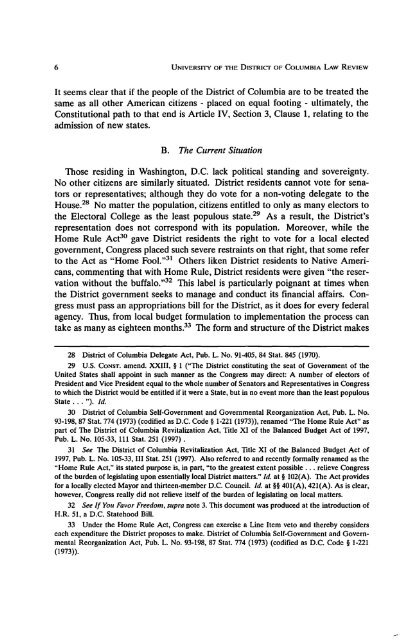Download - UDC Law Review
Download - UDC Law Review
Download - UDC Law Review
You also want an ePaper? Increase the reach of your titles
YUMPU automatically turns print PDFs into web optimized ePapers that Google loves.
6 UNIVERSITY OF THE DISTRIcr OF COLUMBIA LAW REVIEWIt seems clear that if the people of the District of Columbia are to be treated thesame as all other American citizens - placed on equal footing - ultimately, theConstitutional path to that end is Article IV, Section 3, Clause 1, relating to theadmission of new states.B. The Current SituationThose residing in Washington, D.C. lack political standing and sovereignty.No other citizens are similarly situated. District residents cannot vote for senatorsor representatives; although they do vote for a non-voting delegate to theHouse. 28 No matter the population, citizens entitled to only as many electors tothe Electoral College as the least populous state. 29 As a result, the District'srepresentation does not correspond with its population. Moreover, while theHome Rule Act 30 gave District residents the right to vote for a local electedgovernment, Congress placed such severe restraints on that right, that some referto the Act as "Home Fool.,,31 Others liken District residents to Native Americans,commenting that with Home Rule, District residents were given "the reservationwithout the buffalo. ,,32 This label is particularly poignant at times whenthe District government seeks to manage and conduct its financial affairs. Congressmust pass an appropriations bill for the District, as it does for every federalagency. Thus, from local budget formulation to implementation the process cantake as many as eighteen months. 33 The form and structure of the District makes28 District of Columbia Delegate Act, Pub. L. No. 91-405, 84 Stat. 845 (1970).29 u.S. CONST. amend. XXIII, § 1 ("The District constituting the seat of Government of theUnited States shaU appoint in such manner as the Congress may direct: A number of electors ofPresident and Vice President equal to the whole number of Senators and Representatives in Congressto which the District would be entitled if it were a State, but in no event more than the least populousState ... "). Id.30 District of Columbia Self-Government and Governmental Reorganization Act, Pub. L. No.93-198,87 Stat. 774 (1973) (codified as D.C. Code § 1-221 (1973», renamed "The Home Rule Act" aspart of The District of Columbia Revitalization Act, ntle XI of the Balanced Budget Act of 1997,Pub. L. No. 105-33, 111 Stat. 251 (1997) .31 See The District of Columbia Revitalization Act, ntle XI of the Balanced Budget Act of1997, Pub. L. No. 105-33, III Stat. 251 (1997). Also referred to and recently formally renamed as the"Home Rule Act," its stated purpose is, in part, "to the greatest extent possible ... relieve Congressof the burden of legislating upon essentially local District matters." Id. at § 102(A). The Act providesfor a locally elected Mayor and thirteen-member D.C. Council. Id. at §§ 401(A), 421(A). As is clear,however, Congress really did not relieve itself of the burden of legislating on local matters.32 See If You Favor Freedom, supra note 3. This document was produced at the introduction ofH.R. 51, a D.C. Statehood Bill.33 Under the Home Rule Act, Congress can exercise a Line Item veto and thereby considerseach expenditure the District proposes to make. District of Columbia Self-Government and GovernmentalReorganization Act, Pub. L. No. 93-198, 87 Stat. 774 (1973) (codified as D.C. Code § 1-221(1973».














